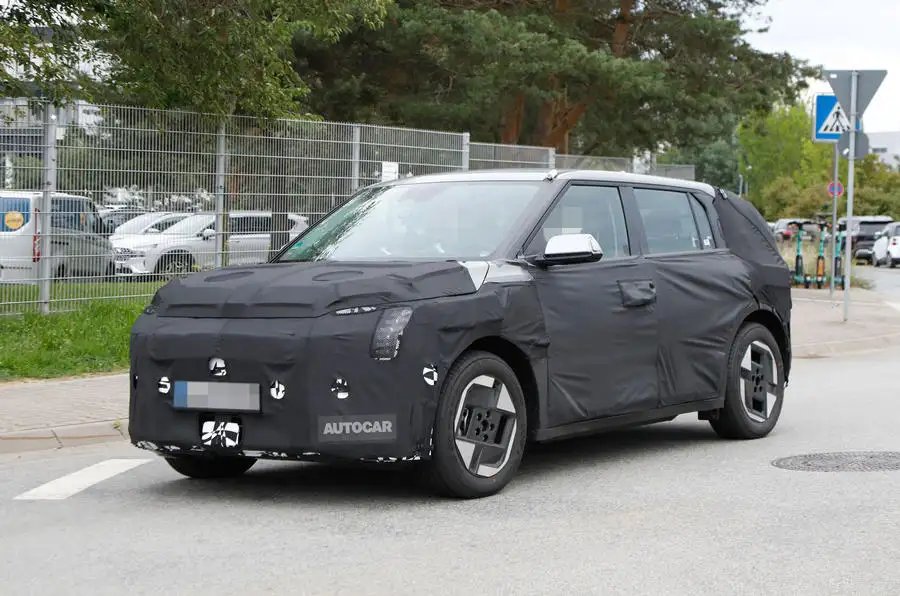Kia EV3 primed as Soul successor with 400 miles of range

Kia’s electric onslaught continues apace: soon after the wraps came off the bold new EV5 SUV, the Korean brand has been spotted testing a much smaller and more city-focused electric car, likely to be called the EV3.
It is the smallest model yet seen in Kia’s EV-badged range of bespoke electric cars, and will leave room for a future EV4 between it and the Sportage-sized EV5.
The early signs suggest that this is a B-segment (compact) model in the vein of the existing Niro EV and Soul EV – which would leave space above for an EV4 closer in size to the Xceed.
Given that the Niro was only recently renewed and is likely to remain on sale in its current form until around 2028, the EV3 will serve as an indirect successor to the Soul EV, which was last significantly updated in 2019.
Certainly, its chunky silhouette, short overhangs and upright glasshouse – just about visible through the heavy camouflage of this prototype – look to position it as a logical replacement for the quirky, boxy crossover.
Unlike the Soul EV, the EV3 will use a bespoke electric Hyundai Motor Group platform, which will allow for better range, charging times and functionality.
Indeed, riding on an EV-specific platform will make for tangible improvements in cabin space and packaging over the electric Soul, which is based on the same platform as the petrol-engined version that’s still sold in certain markets.
Possibilities include the introduction of a hidden storage cubby under flat-folding rear seats and a bench-style front seat, as in the EV5, and it’s highly likely that the front end houses a small ‘frunk’.
The EV3 is obviously more overtly geared towards urban use than the bold, 4x4-inspired EV5 (pictured below) and EV9. However, it will – as dictated by Kia’s new Opposites United design ethos – adopt similarly blocky styling, chunky plastic cladding, distinctive LED light signatures and a bold ‘tiger face’ front end.
This test car gives an early look at the EV3’s striking flat-faced wheel designs, which appear to have been designed to promote aerodynamic efficiency while injecting a hint of rugged appeal.
Importantly, Kia parent company Hyundai Motor Group has confirmed that from 2025 it will begin launching models atop its new eM platform for passenger EVs – at the same time as launching a range of ‘purpose-built’ commercial vehicles on a separate EV architecture called eS.
Details remain unclear on how exactly the eM platform will be differentiated from the e-GMP structure used by Hyundai’s and Kia’s latest EVs, but it’s highly likely that the two will coexist for several years, with the eM potentially being rolled out as a replacement for the adapted combustion car platforms used by the current Niro EV and Soul EV.
The company said the eM was “being developed specifically for EVs across all segments and will provide a 50% improvement in driving range on a single charge compared to current EVs”, adding: “The eM platform is also being developed to support level-three or higher autonomous driving technology and over-the-air software-update features.”
This suggests that any cars on this platform – likely to include the EV3 – could get more than 400 miles of official range.
It hasn’t yet been confirmed whether the eM will accommodate 800V rapid-charging hardware, though. Notably, the EV5 revealed recently uses a 400V system – although that figure applies to the Chinese-market model, to be built locally, and it’s possible that Kia could also build the EV5 elsewhere for sale in other global markets, using bespoke underpinnings with different attributes.
Being sized to take on the Jeep Avenger, Mini Aceman and Peugeot e-2008 will make pricing core to the EV3’s positioning, and it stands to reason that Kia could keep its pricing accessible by reserving top-level charging and performance for its larger, more expensive EVs.
A crucial development for the eM platform will be the introduction of a new standardised approach to component sharing across model lines.
The Hyundai Motor Group said: “By standardising the batteries and electric motors, for example, which currently vary across each EV model, the company will flexibly apply common components to each vehicle, thus efficiently expanding its line-up.”
Furthermore, a new integrated vehicle controller unit will make for “more systematic and efficient” software upgrades for each car and allow Hyundai and Kia to better tailor each of their models to specific global markets, with bespoke features and varying performance.
The EV3 is one of 11 new EVs scheduled to be launched by 2027 under Kia’s Plan S electrification strategy and is expected to be unwrapped late next year ahead of a launch in 2025.
